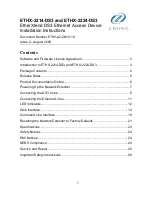
Chapter 4. Web Configuration & Operation
83
CHAPTER 3
WEB OPERATION & CONFIGURATION
Event Seconds Summary Threshold:
This two-octet field indicates the number of errored frame seconds in the period
is required to be equal to or greater than in order for the event to be generated, encoded as a 16-bit unsigned integer.
Event Seconds Summary Events:
This two-octet field indicates the number of errored frame seconds in the period,
encoded as a 16-bit unsigned integer.
Event Seconds Summary Error Total:
This four-octet field indicates the sum of errored frame seconds that have been
detected since the OAM sub-layer was reset.
Event Seconds Summary Event Total:
This four-octet field indicates the number of Errored Frame Seconds Summary
Event TLVs that have been generated since the OAM sub-layer was reset, encoded as a 32bit unsigned integer.
3.6.6 Remote Device
This device enables users to configure features of the remote FRM220-MSW404 device using proprietary in-band
management protocol. To do so, the local FRM220-MSW404 device must be set to “Active” mode. The remote device
can be set to either “Active” or “Passive” mode. Once two devices are successfully connected, click on the “Remote A”,
“Remote B”, “Remote C” or “Remote D” option on the left function menu in local FRM220-MSW404 device. Then, the
screen same as above will appear.
NOTE:
Apart from the method described above to manage the remote FRM220-MSW404 device in local side, both
local and remote FRM220-MSW404 devices can also be managed via NMC card in FRM220 chassis. However, using
this method only enables the NMC to manage two remote devices that are connected with the slide-in local FRM220-
MSW404 via fiber optical cables. For detailed descriptions about proprietary in-band management via FRM 220
chassis, please refer to FRM220 user manual.
















































